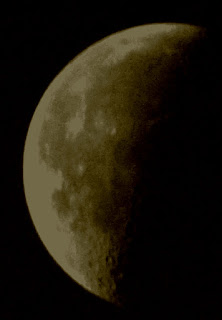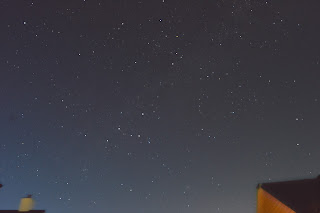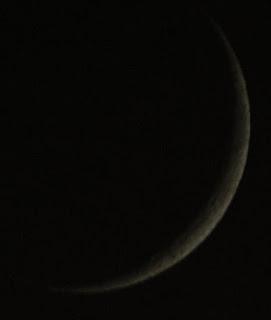July 29th 2210 GMT Saturn
There was a lot of cloud around but
Saturn was showing somewhat east of south. I took my 127mm Maksutov out and has
a clear view with my 32mm Plossl eyepiece delivering a magnification of 64x. I
could clearly see the rings and the space between the planet and rings but no
other detail. I tried some afocal shots with my DSLR on automatic settings at
various focal lengths.
I then tried prime focus at 1.54 metres focal length, ISO 100 and various exposures from 1/20 second to 1/5 second. 1/20 second was best.
July 24th 1420 GMT Sun
July 21st 0605 GMT Moon and
Sun
I changed my settings to 300mm focal length, ISO 100 and 1/1600 second exposure, added a filter and snapped the Sun
July 18th 0510 GMT Moon and Sun
I snapped the Moon at 300mm focal length,
ISO 400 and 1/400 second exposure.
I added a solar filter to my camera and
changed my settings to 300mm focal length, ISO 100 and 1/1000 second exposure.
I used a longer exposure for the Sun, as it was very low.
July 16th 1130 GMT Sun
July 16th 0110 GMT Moon, Jupiter and Saturn
The Moon was low and conditions were
hazy. As the Moon and Saturn were close together, I snapped them together and
individually at 300mm focal length ISO 100 and 1/800 second exposure for the
Moon and 1/50 second for Saturn.
I snapped Jupiter at 300mm focal length ISO 100 and 1/200 second exposure but did not get any details.
I went for Jupiter’s moons at 300mm focal
length ISO 6400 and 2 seconds exposure.
July 15th 0510 GMT Sun
The Sun was low and partly obscured.
July 14th 0610 GMT Sun
I bin scanned the sun in clear conditions and caught a
sunspot or three.
July 11th 0510 GMT Sun
July 10th 1420 GMT Sun
The sky was spotted with patchy cloud,
with clear areas in between. A binocular scan, with filters, showed four of the
five sunspots on the Learmonth images.
July 10th 0030 GMT Planets and Deep Sky
I attempted to capture Jupiter’s moons
with my DSLR at 300mm focal length, ISO 6400 and 2 seconds exposure.
I tried the planet at 300mm focal length, ISO 100 and 1/100 second exposure.
I then tried Saturn at 300mm focal length, ISO 100 and 1/15 second exposure.
I reverted back to 300mm focal length, ISO 6400 and 2 seconds exposure and started a deep sky shoot. I took about 20 frames for each target.
First up was my old faithful of Melotte 20.
I kept trying for the Perseus Double Cluster and failed.
Next up was the Andromeda Galaxy (M31).
Returning to Perseus, I caught the star cluster M34.
I then caught the Perseus Double Cluster.
I ended up with the Pinwheel Galaxy (M33). Or... so I thought but I was aiming at the Andromeda Galaxy instead. It wasn't a total loss, as one of the shots caught a meteor.
I shot a few dark frames. As I packed my gear away, dawn was breaking.
July 9th 2220 GMT Moon
July 9th 1230 GMT Sun
It cleared enough to see the Sun but I
decided to have a go with my Coronado PST. I had not got a decent set of images
from it for a while and had just about given up. I wondered if cleaning the
objective lens would work but hadn’t managed to unscrew it.
I set up with a tripod and 15mm focal
length eyepiece, delivering a magnification of just under 27x. Immediately, I
could see sunspots but etalon tuning (adjusting the wavelength of light coming
through) only revealed a hint of plages surrounding the sunspots.
I took some afocal shots with my camera
‘phone (possibly a silly idea!) and with my DSLR. I tried various camera focal
lengths and hoped for the best. This was the best. I caught some hydrogen alpha features but not as many as I'd hoped.
July 9th 1100 GMT Sun
Being a Saturday, I was thinking of taking my Mak and filter out for a solar shoot but it was a case of cloud-dodging for clear patches. I could see some sunspots though my camera viewfinder, so I thought that a DSLR only shot, at my usual settings would produce a result.
July 8th 0510 GMT Sun
I photographed the Sun with my DSLR and filter at 300mm focal length, ISO 100 and 1/2000 second exposure.
July 7th 1540 GMT Moon and Sun
I snapped the
Moon with my DSLR at 300mm focal length, ISO 400 and 1/500 second exposure.
I added a
filter to the set-up to snap the Sun at 300mm focal length, ISO 100 and 1/2000
second exposure.
July 5th 0505 GMT Sun
I snapped the Sun with my DSLR and filter at 300mm focal length, ISO 100 and 1/2000 second exposure.
July 4th 0505 GMT Sun
There was some cloud around when I did a
bin scan of the Sun. I only saw one os the sunspots that I had photographed the
day before.
July 3rd 2030 GMT Moon
July 3rd 0920 GMT Sun
So finally, after so long without being
able to use my 127mm Maksutov for white light photography or viewing, I finally
took it out with my new filter and DSLR.
As there were two sunspots close together, I attempted a close-up at 4.62 metres focal length, ISO 100 and 1/100 second exposure.
July 3rd 2300 GMT Meteor Hunt/Constellations
This time I aimed my camera, with its usual settings at Aquila. It was a bit murky but there was a small chance of catching an Anthelion meteor, as well as any sporadic meteors that might have been in the area.
At 2315 GMT, I caught a meteor near Aquila.
At 2323 GMT, I caught another one in the same part of the sky.
As usual, I started stacking constellation shots. With Aquila, there was Scutum, Sagitta, Delphinus and Vulpecula.
July 2nd 2110 GMT Moon
July 1st 2250 GMT Meteor Hunt and Constellations
July 1st 2050 GMT Moon
The thin waxing crescent moon hung low in
the north west after sunset. It was just about to disappear behind some trees
and I had to walk a few yards from our front door to see it. I used my DSLR at
300mm focal length, ISO 400 and 1/200 second exposure.

















































No comments:
Post a Comment